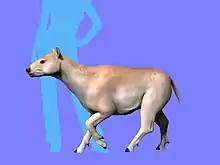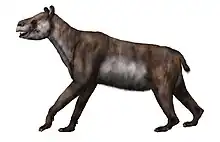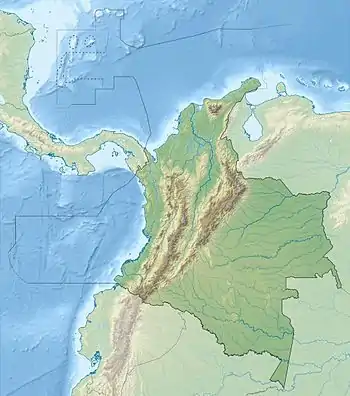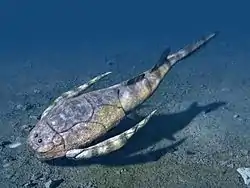| Etayoa | |
|---|---|
 | |
| Life restoration | |
| Scientific classification | |
| Domain: | Eukaryota |
| Kingdom: | Animalia |
| Phylum: | Chordata |
| Class: | Mammalia |
| Order: | †Xenungulata |
| Family: | †Carodniidae |
| Genus: | †Etayoa Villarroel, 1987 |
| Species: | †E. bacatensis |
| Binomial name | |
| †Etayoa bacatensis Villarroel 1987 | |
Etayoa is an ungulate of the family Carodniidae in the order Xenungulata that lived during the Early Eocene (~ 55 Ma) in northern South America.
Etymology
The genus of the type species Etayoa bacatensis was named by palaeontologist Carlos Villarroel after Fernando Etayo Serna, who contributed extensively to the paleontology and stratigraphy research in Colombia.[1] The species epithet bacatensis refers to Bacatá,[2] the name in Muysccubun for the main settlement of the southern Muisca Confederation; the name of which has been used for the current Colombian capital Bogotá, founded in a different location than the original Bacatá.
Description
The type species fossil specimen consists of a partial mandible with teeth, found in the Bogotá Formation in the locality Ciudad Bolívar of Bogotá, Colombia.[3] The estimated size of the ungulate is the size of a dog.[4]
Paleoclimate and environment
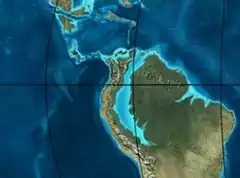
by Ron Blakey
The finds of iguanians, including the fossil record of hoplocercines, and boine, caenophidian, and ungaliophiine snakes in the Bogotá Formation indicate a tropical forest environment, present just before the Early Eocene Climatic Optimum (EECO).[5] The abundant paleosols of the Bogotá Formation show an increase in chemical weathering across the Paleocene-Eocene (P-E) transition; the Paleocene–Eocene Thermal Maximum.[6]
References
- ↑ (in Spanish) 2012 - Etayoa bacatensis, un mamífero de hace 55 millones - Paleontología en Colombia - accessed 21-04-2016
- ↑ Villarroel, 1987
- ↑ 1987 - Description of Etayoa bacatensis - Paleobiology Database
- ↑ (in Spanish) 2011 - Un xenungulado del Paleoceno de la sabana de Bogotá - Paleontología en Colombia
- ↑ Head et al., 2012
- ↑ Morón et al., 2013
Bibliography
- Head, Jason J.; Jonathan Ivan Bloch; Aldo F. Rincón, and Jorge W. Moreno Bernal. 2012. Paleogene Squamates from the Northern neotropics: Ecological Implications and Biogeographic Histories (Abstract). Journal of Vertebrate Paleontology 72nd Annual Meeting of the Society of vertebrate Paleontology, At Raleigh, North Carolina. _. Accessed 2017-03-29.
- Morón, Sara; David L. Fox; Joshua M. Feinberg; Carlos Jaramillo; Germán Bayona; Camilo Montes, and Jonathan Ivan Bloch. 2013. Climate change during the Early Paleogene in the Bogotá Basin (Colombia) inferred from paleosol carbon isotope stratigraphy, major oxides, and environmental magnetism (Abstract). Palaeogeography, Palaeoclimatology, Palaeoecology 388. 115-127. Accessed 2017-03-29.
- Villarroel A., Carlos. 1987. Características y afinadas de Etayoa n. gen., tipo de una nueva familia de Xenungulata (Mammalia) del Paleoceno Medio (?) de Colombia. Comunicaciones Paleontológicas del Museo de Historia Natural de Montevideo 19. 241-254. Accessed 2017-03-29.
Further reading
- Bloch, Jonathan Ivan; Edwin Cadena; Alexander Hastings; Aldo F. Rincón, and Carlos Jaramillo. 2008. Vertebrate faunas from the Paleocene Bogotá Formation of northern Colombia (Abstract). Journal of Vertebrate Paleontology Society of Vertebrate Paleontology, 68th Annual Meeting. _. Accessed 2017-03-29.
- Head, Jason J.; Jonathan Ivan Bloch; Aldo F. Rincón; Jason R. Bourque, and Carlos Jaramillo. 2011. An enigmatic derived snake from the earliest Eocene of equatorial South America (Abstract). Journal of Vertebrate Paleontology Society of Vertebrate Paleontology, 71st Annual Meeting, Las Vegas, NV. _. Accessed 2017-03-29.
- Herrera, Fabiany; Steven R. Manchester; Mónica R. Carvalho; Carlos Jaramillo, and Scott L. Wings. 2014. Paleocene wind-dispersed fruits and seeds from Colombia and their implications for early Neotropical rainforests. Acta Paleobotanica 54. 197-229. Accessed 2017-03-29.
- Woodburne, Michael O.; Francisco J. Goin; Mariano Bond; Alfredo A. Carlini; Javier N. Gelfo; Guillermo M. López; A. Iglesias, and Ana N. Zimicz. 2014. Paleogene Land Mammal Faunas of South America; a Response to Global Climatic Changes and Indigenous Floral Diversity. Journal of Mammalian Evolution 21. 1-73. Accessed 2017-03-29.
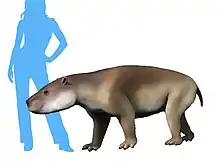
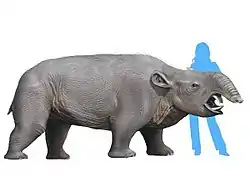

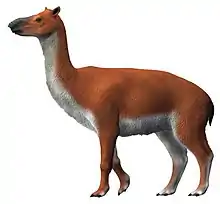
.jpg.webp)
